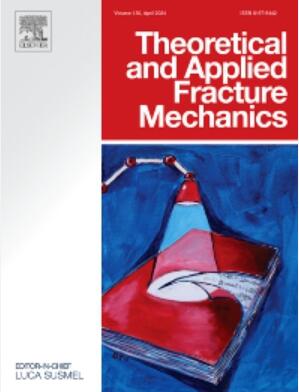Mixed-mode fracture: Combination of Arcan fixture and stereo-DIC
IF 5
2区 工程技术
Q1 ENGINEERING, MECHANICAL
引用次数: 0
Abstract
To characterise mixed-mode fracture, including mode , a combination of Arcan fixture, that offers both in-plane and out-of-plane loading, and stereo digital image correlation (DIC) has proven valuable for measuring in-plane and out-of-plane surface displacement and deformation fields while allowing for direct stress intensity factor (SIF) extraction throughout the tests, but it comes with many caveats. Using stereo DIC, the mixed mode fracture behaviour of PMMA is analysed using a novel mode decomposition technique that combines experimental and analytical approaches. This technique divides the measured displacement field from digital image correlation into three distinct components: a symmetric field (), an in-plane anti-symmetric field (), and an out-of-plane antisymmetric field (), decomposed by a difference operation on the reflected and non-reflected fields about the crack plane. Then, the strain energy release rate of the crack is calculated for each loading mode using finite elements without knowledge of the sample geometry or nominal loading condition. Our work revealed parasitic loading modes induced by the Archan fixture plus other intrinsic sources related to load accommodation. Nevertheless, the calculated SIFs measured during stable crack growth were normalised using different fracture toughness () values with of 1.82 ± 0.32 MPa m0.5, providing the best fit to the fracture loci with an R2 of 0.95. This value agrees well with the ASTM-obtained value of 1.7 MPa m0.5.
混合模式断裂:阿肯夹具与立体 DIC 的结合
为了确定混合模式断裂(包括模式 III)的特征,阿肯夹具(提供面内和面外加载)与立体数字图像相关性(DIC)相结合,被证明对测量面内和面外表面位移和变形场非常有价值,同时还能在整个测试过程中直接提取应力强度因子(SIF),但也有许多注意事项。使用立体 DIC,结合实验和分析方法的新型模式分解技术对 PMMA 的混合模式断裂行为进行了分析。该技术将数字图像相关测量的位移场分为三个不同的部分:对称场(uI)、平面内反对称场(uII)和平面外反对称场(uIII),通过对裂纹平面的反射场和非反射场进行差分运算进行分解。然后,在不了解样品几何形状或标称加载条件的情况下,使用有限元计算每种加载模式下裂纹的应变能释放率。我们的工作揭示了由 Archan 夹具引起的寄生加载模式,以及与负载容纳相关的其他内在来源。尽管如此,在稳定裂纹生长过程中测得的 SIF 计算值使用不同的断裂韧性 (KIC) 值进行归一化,KIC 值为 1.82 ± 0.32 MPa m0.5,与断裂位置的拟合效果最佳,R2 为 0.95。该值与 ASTM 得出的 1.7 MPa m0.5 值非常吻合。
本文章由计算机程序翻译,如有差异,请以英文原文为准。
求助全文
约1分钟内获得全文
求助全文
来源期刊

Theoretical and Applied Fracture Mechanics
工程技术-工程:机械
CiteScore
8.40
自引率
18.90%
发文量
435
审稿时长
37 days
期刊介绍:
Theoretical and Applied Fracture Mechanics'' aims & scopes have been re-designed to cover both the theoretical, applied, and numerical aspects associated with those cracking related phenomena taking place, at a micro-, meso-, and macroscopic level, in materials/components/structures of any kind.
The journal aims to cover the cracking/mechanical behaviour of materials/components/structures in those situations involving both time-independent and time-dependent system of external forces/moments (such as, for instance, quasi-static, impulsive, impact, blasting, creep, contact, and fatigue loading). Since, under the above circumstances, the mechanical behaviour of cracked materials/components/structures is also affected by the environmental conditions, the journal would consider also those theoretical/experimental research works investigating the effect of external variables such as, for instance, the effect of corrosive environments as well as of high/low-temperature.
 求助内容:
求助内容: 应助结果提醒方式:
应助结果提醒方式:


